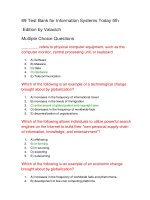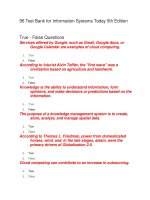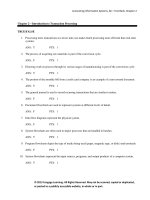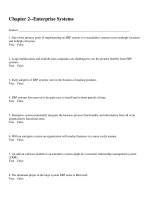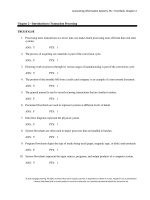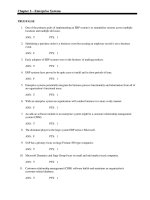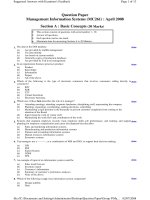Test bank accounting information systems 14e
Bạn đang xem bản rút gọn của tài liệu. Xem và tải ngay bản đầy đủ của tài liệu tại đây (116.97 KB, 38 trang )
Accounting Information Systems, 14e, Global Edition (Romney/Steinbart)
Chapter 1 Conceptual Foundations of Accounting Information Systems
1 Distinguish data from information, discuss the characteristics of useful information, and
explain how to determine the value of information.
1) Which of the following statements below shows the contrast between data and information?
A) Data is the primary output of an accounting information system.
B) Information is the primary output of an accounting information system.
C) Data is more useful in decision making than information.
D) Data and information are the same.
Answer: B
Concept: The concept of information
Objective: Learning Objective 1
Difficulty: Easy
AACSB: Analytical Thinking
2) When a subsystem's goals are inconsistent with the goals of another subsystem or with the
system as a whole, it creates
A) system inconsistence.
B) system conflict.
C) goal inconsistence.
D) goal conflict.
Answer: D
Concept: The concept of information
Objective: Learning Objective 1
Difficulty: Easy
AACSB: Analytical Thinking
3) When a subsystem achieves its goals while contributing to the organization's overall goal, it is
called
A) system match.
B) system congruence.
C) goal congruence.
D) goal match.
Answer: B
Concept: The concept of information
Objective: Learning Objective 1
Difficulty: Easy
AACSB: Analytical Thinking
1
Copyright © 2018 Pearson Education, Ltd.
4) Information is best described as
A) raw facts about transactions.
B) data that has been organized and processed so that it is meaningful to the user.
C) facts that are useful when processed in a timely manner.
D) the same thing as data.
Answer: B
Concept: The concept of information
Objective: Learning Objective 1
Difficulty: Easy
AACSB: Analytical Thinking
5) The value of information can best be determined by
A) its usefulness to decision makers.
B) its relevance to decision makers.
C) the benefits associated with obtaining the information minus the cost of producing it.
D) the extent to which it optimizes the value chain.
Answer: C
Concept: The concept of information
Objective: Learning Objective 1
Difficulty: Moderate
AACSB: Analytical Thinking
6) An accounting information system (AIS) processes ________ to provide users with ________.
A) data; information
B) data; transactions
C) information; data
D) data; benefits
Answer: A
Concept: The concept of information
Objective: Learning Objective 1
Difficulty: Easy
AACSB: Analytical Thinking
7) ________ information reduces uncertainty, improves decision makers' ability to make
predictions, or confirms expectations.
A) Timely
B) Reliable
C) Relevant
D) Complete
Answer: C
Concept: Information needs and business processes
Objective: Learning Objective 1
Difficulty: Easy
AACSB: Analytical Thinking
2
Copyright © 2018 Pearson Education, Ltd.
8) Information that is free from error or bias and accurately represents the events or activities of
the organization is
A) relevant.
B) reliable.
C) verifiable.
D) timely.
Answer: B
Concept: The concept of information
Objective: Learning Objective 1
Difficulty: Easy
AACSB: Analytical Thinking
9) Information that does not omit important aspects of the underlying events or activities that it
measures is
A) complete.
B) accessible.
C) relevant.
D) timely.
Answer: A
Concept: The concept of information
Objective: Learning Objective 1
Difficulty: Easy
AACSB: Analytical Thinking
10) Information is ________ when two knowledgeable people independently produce the same
information.
A) verifiable
B) relevant
C) reliable
D) complete
Answer: A
Concept: The concept of information
Objective: Learning Objective 1
Difficulty: Easy
AACSB: Analytical Thinking
3
Copyright © 2018 Pearson Education, Ltd.
11) Data must be converted into information to be considered useful and meaningful for decision
making. There are seven characteristics that make information both useful and meaningful. If
information is free from error or bias and accurately represents the events or activities of the
organization, it is representative of the characteristic of
A) relevancy.
B) timeliness.
C) understandability.
D) reliability.
Answer: D
Concept: The concept of information
Objective: Learning Objective 1
Difficulty: Easy
AACSB: Analytical Thinking
12) Data must be converted into information to be considered useful and meaningful for decision
making. There are seven characteristics that make information both useful and meaningful. If
information can help reduce uncertainty, improves decision making, or confirms or corrects prior
expectations, it is representative of the characteristic of
A) reliability.
B) relevance.
C) complete.
D) truthful.
Answer: B
Concept: The concept of information
Objective: Learning Objective 1
Difficulty: Easy
AACSB: Analytical Thinking
13) Data must be converted into information to be considered useful and meaningful for decision
making. There are seven characteristics that make information both useful and meaningful. If the
same information can be reproduced by two independent and knowledgeable people, it is
representative of the characteristic of
A) reliability.
B) relevance.
C) verifiability.
D) truthful.
Answer: C
Concept: The concept of information
Objective: Learning Objective 1
Difficulty: Easy
AACSB: Analytical Thinking
4
Copyright © 2018 Pearson Education, Ltd.
14) Data must be converted into information to be considered useful and meaningful for decision
making. There are seven characteristics that make information both useful and meaningful. If the
information is free from error or bias, it is representative of the characteristic of
A) reliability.
B) relevance.
C) verifiability.
D) truthful.
Answer: A
Concept: The concept of information
Objective: Learning Objective 1
Difficulty: Easy
AACSB: Analytical Thinking
15) Inventory information for Sun Corp. is provided in real time by a firm's accounting
information system. However, the accuracy of this information is questionable. Many store
managers often report stock outs of components that the system indicates are in stock. Which of
the following characteristics of useful information is absent in the situation described above?
A) relevant
B) reliable
C) complete
D) timely
E) understandable
F) verifiable
G) accessible
Answer: B
Concept: The concept of information
Objective: Learning Objective 1
Difficulty: Moderate
AACSB: Analytical Thinking
5
Copyright © 2018 Pearson Education, Ltd.
16) Sam Jones has been the controller of Downtown Tires for 25 years. Ownership of the firm
recently changed hands and the new owners are conducting an audit of the financial records. The
audit has been unable to reproduce financial reports that were prepared by Sam. While there is no
evidence of wrongdoing, the auditors are concerned that the discrepancies might contribute to
poor decisions. Which of the following characteristics of useful information is absent in the
situation described above?
A) relevant
B) reliable
C) complete
D) timely
E) understandable
F) verifiable
G) accessible
Answer: F
Concept: The concept of information
Objective: Learning Objective 1
Difficulty: Moderate
AACSB: Analytical Thinking
17) Sam Jones has been the controller of Downtown Tires for 25 years. Ownership of the firm
recently changed hands and the new owners are conducting an audit of the financial records. The
audit has been unable to obtain the firm's financial statements that were prepared by Sam. While
there is no evidence of wrongdoing, the auditors are not able to complete the audit. Which of the
following characteristics of useful information is absent in the situation described above?
A) relevant
B) reliable
C) complete
D) timely
E) understandable
F) verifiable
G) accessible
Answer: G
Concept: The concept of information
Objective: Learning Objective 1
Difficulty: Moderate
AACSB: Analytical Thinking
6
Copyright © 2018 Pearson Education, Ltd.
18) In 2015, Singh Manufacturing implemented a Web-based information system that allows all
employees to access mission-critical information. The intention was to increase production
efficiency. Unfortunately, it had the opposite effect, as deliveries fell behind schedule and costs
increased. Shaman Gupta, the director of information technology services, asked Ashlee Wells to
come in and talk with him about the system. Ashlee is a long-time employee of Singh, and her
opinion is valued by her peers and by her supervisor.
"So Ashlee, how's it going down there in the shop?"
"Not so good, Shaman. Used to be we got a weekly pick list so we knew how to plan production.
Now, we got that computer system. Most of us can't figure out how to use it to do our jobs. Is
there some way to print out a pick list?"
Shaman thought for a while before responding. "Well, Ashlee, to tell you the truth, I'm not so
sure how to do it myself, but there must be a way. We'll bring in the consultants that helped us
build the system. Maybe they can help."
Which of the following characteristics of useful information is absent in the situation described
above?
A) relevant
B) reliable
C) complete
D) timely
E) understandable
F) verifiable
G) accessible
Answer: E
Concept: The concept of information
Objective: Learning Objective 1
Difficulty: Moderate
AACSB: Analytical Thinking
7
Copyright © 2018 Pearson Education, Ltd.
19) In 2015, Singh Manufacturing implemented a Web-based information system that allows all
employees to access mission-critical information. The intention was to increase production
efficiency. Unfortunately, it had the opposite effect, as deliveries fell behind schedule and costs
increased. Shaman Gupta, the director of information technology services, asked Ashlee Wells to
come in and talk with him about the system. Ashlee is a long-time employee of Singh, and her
opinion is valued by her peers and by her supervisor.
"So Ashlee, how's it going down there in the shop?"
"Not so good, Shaman. Used to be we got a weekly pick list so we knew how to plan production.
Now, we got that computer system. Most of the time we can't get all of the information that we
need. Is there some way to print out a list that has everything that we need?"
Shaman thought for a while before responding. "Well, Ashlee, to tell you the truth, I'm not so
sure how to do it myself, but there must be a way. We'll bring in the consultants that helped us
build the system. Maybe they can help."
Which of the following characteristics of useful information is absent in the situation described
above?
A) relevant
B) reliable
C) complete
D) timely
E) understandable
F) verifiable
G) accessible
Answer: C
Concept: The concept of information
Objective: Learning Objective 1
Difficulty: Moderate
AACSB: Analytical Thinking
8
Copyright © 2018 Pearson Education, Ltd.
20) Wisconsin Dells, Wisconsin, is a popular tourist destination. During the winter months, the
population dwindles to a meager few, but when summer comes, the size of the town surges.
Hunter Jackson is the town sanitation engineer. When the size of the town surges, so do his
responsibilities. Among them is management of the sewage processing volume.
In an interview with the local paper, Hunter complained that a report on tourist population that he
uses to adjust processing volume refers to data that was collected four days ago and it takes him
a week to make adjustments.
Which of the following characteristics of useful information is absent in the situation described
above?
A) relevant
B) reliable
C) complete
D) timely
E) understandable
F) verifiable
G) accessible
Answer: D
Concept: The concept of information
Objective: Learning Objective 1
Difficulty: Moderate
AACSB: Analytical Thinking
21) Wisconsin Dells, Wisconsin, is a popular tourist destination. During the winter months, the
population dwindles to a meager few, but when summer comes, the size of the town surges.
Hunter Jackson is the town sanitation engineer. When the size of the town surges, so do his
responsibilities. Among them is management of the sewage processing volume.
In an interview with the local paper, Hunter complained that a report on tourist population that he
uses to adjust processing volume refers to data that was not always accurate and it is really
giving him a hard time to make adjustments.
Which of the following characteristics of useful information is absent in the situation described
above?
A) relevant
B) reliable
C) complete
D) timely
E) understandable
F) verifiable
G) accessible
Answer: B
Concept: The concept of information
Objective: Learning Objective 1
Difficulty: Moderate
AACSB: Analytical Thinking
9
Copyright © 2018 Pearson Education, Ltd.
22) A frantic Barney Rubble lost a large sale because he could not access the system to verify the
inventory was in stock and ready to be shipped. Which of the following characteristics of useful
information is absent in the situation described above?
A) relevant
B) reliable
C) complete
D) timely
E) understandable
F) verifiable
G) accessible
Answer: G
Concept: The concept of information
Objective: Learning Objective 1
Difficulty: Easy
AACSB: Analytical Thinking
23) Message left on voicemail: "Hi Nikki! Just landed at the airport. How about dinner this
evening if you're available. Call me!" Which of the following characteristics of useful
information is absent in the situation described above?
A) relevant
B) reliable
C) complete
D) timely
E) understandable
F) verifiable
G) accessible
Answer: C
Concept: The concept of information
Objective: Learning Objective 1
Difficulty: Moderate
AACSB: Analytical Thinking
10
Copyright © 2018 Pearson Education, Ltd.
24) Chopra, Limited, is an Indian company operating in New York state. It offers stylized,
boutique public relations services to upscale retailers in quaint New England towns. A major
source of revenue is a weekly newsletter that reports on current and projected tourist travel and
spending patterns. Preparation of the newsletter requires study and analysis of weather
conditions, economic activity, and travel costs. It is available at an annual subscription rate of
$299.99. There are currently 190 subscribers. Preparation and distribution of the newsletter costs
$12,000 annually. The value of information to subscribers is
A) $236.83.
B) $44,998.10.
C) less than $63.16.
D) at least $300.00.
Answer: D
Concept: Information needs and business processes
Objective: Learning Objective 1
Difficulty: Easy
AACSB: Application of Knowledge
25) Chopra, Limited, is an Indian company operating in New York state. It offers stylized,
boutique public relations services to upscale retailers in quaint New England towns. A major
source of revenue is a weekly newsletter that reports on current and projected tourist travel and
spending patterns. Preparation of the newsletter requires study and analysis of weather
conditions, economic activity, and travel costs. It is available at an annual subscription rate of
$299.99. There are currently 190 subscribers. Preparation and distribution of the newsletter costs
$12,000 annually. Chopra has always been able to manage to keep its newsletter operation above
their breakeven point. The value of information to Chopra is
A) $236.83.
B) $44,998.10.
C) less than $63.16.
D) at least $12,000.
Answer: D
Concept: Information needs and business processes
Objective: Learning Objective 1
Difficulty: Moderate
AACSB: Application of Knowledge
11
Copyright © 2018 Pearson Education, Ltd.
26) Baggins Incorporated identifies new product development and product improvement as the
top corporate goals. An employee developed an innovation that will correct a shortcoming in one
of the company's products. Although Baggins current Return on Investment (ROI) is 12%, the
product innovation is expected to generate ROI of only 10%. As a result, awarding bonuses to
employees based on ROI resulted in
A) goal conflict.
B) information overload.
C) goal congruence.
D) decreased value of information.
Answer: A
Concept: Information needs and business processes
Objective: Learning Objective 1
Difficulty: Challenging
AACSB: Application of Knowledge
27) Baggins Incorporated identifies new product development and product improvement as the
top corporate goals. An employee developed an innovation that will correct a shortcoming in one
of the company's products. Although Baggins current Return on Investment (ROI) is 10%, the
product innovation is expected to generate ROI of 15%. As a result, awarding bonuses to
employees based on ROI resulted in
A) goal conflict.
B) information overload.
C) goal congruence.
D) decreased value of information.
Answer: C
Concept: Information needs and business processes
Objective: Learning Objective 1
Difficulty: Challenging
AACSB: Application of Knowledge
28) Which of the following tradeoffs between characteristics of useful information is least
objectionable?
A) incomplete information received on a timely basis
B) irrelevant information received in an understandable format
C) unreliable information easily accessible
D) verifiable information received in unreadable format
Answer: A
Concept: Information needs and business processes
Objective: Learning Objective 1
Difficulty: Moderate
AACSB: Analytical Thinking
12
Copyright © 2018 Pearson Education, Ltd.
29) Which of the following is not one of the three basic types of data about a specific sales
transaction that should be captured by an Accounting Information System?
A) name of the employee who completed the sale
B) daily sales quota
C) product sold
D) date
Answer: B
Concept: Information needs and business processes
Objective: Learning Objective 1
Difficulty: Easy
AACSB: Analytical Thinking
30) Define the concept of a system.
Answer: A system is a set of two or more components that are somehow interrelated and interact
together to achieve a specific goal.
Concept: The concept of information
Objective: Learning Objective 1
Difficulty: Easy
AACSB: Analytical Thinking
31) Define data, information, and how the value of information is determined.
Answer: Data: facts that are collected, entered, recorded, stored, and processed by an AIS.
Information: data that has been organized and processed and is meaningful to its users. Such
information is accessible, relevant, timely, reliable, verifiable, complete, and understandable.
Information is of value when the benefits received from using or acting upon it outweigh the cost
to produce the information.
Concept: Information needs and business processes
Objective: Learning Objective 1
Difficulty: Easy
AACSB: Analytical Thinking
32) Discuss the concept of a system and the issues of goal conflict and goal congruence.
Answer: A system is a set of two or more components that are somehow interrelated and interact
together to achieve a specific goal. A system usually consists of smaller components called
subsystems. These subsystems have specific and defined functions, which interact with and
support the larger system. The concept of systems is key to information technology and AIS. All
systems, including the AIS, must work to achieve one or more organizational goals. Goal conflict
results when a decision or action of a subsystem is inconsistent with another subsystem or the
system (organization) as a whole. Goal congruence results when a subsystem achieves its goals
while contributing to the organization's overall goal. Subsystems should maximize organizational
goals.
Concept: The concept of information
Objective: Learning Objective 1
Difficulty: Moderate
AACSB: Analytical Thinking
13
Copyright © 2018 Pearson Education, Ltd.
33) Discuss the seven characteristics of useful information.
Answer: The seven characteristics of useful information are: relevant, reliable, complete, timely,
understandable, verifiable and accessible. These characteristics are qualities that information
should possess to be useful in a business environment. Briefly stated, in order for information to
be useful it must be: 1) relevant, meaning that it reduces uncertainty and adds to the decisionmaking process; 2) reliable information is information that is free from error, and is accurate in
its nature; 3) complete information is information that does not omit any important data, facts, or
aspects about events or activities; 4) information is timely when it is fully available to enable the
decision-making process to proceed; 5) understandable information must be both in an
intelligible and useful format; 6) information is considered verifiable if two people, acting
independently of each other, produce the same information or the same results. 7) Information is
accessible if it is available to users when they need it and in a format they can use.
Concept: The concept of information
Objective: Learning Objective 1
Difficulty: Moderate
AACSB: Analytical Thinking
34) Discuss the concept of a system and the issues of goal conflict and goal congruence.
Answer: A system is a set of two or more components that are somehow interrelated and interact
together to achieve a specific goal. A system usually consists of smaller components called
subsystems. These subsystems have specific and defined functions, which interact with and
support the larger system. The concept of systems is key to information technology and AIS. All
systems, including the AIS, must work to achieve one or more organizational goals. Goal conflict
results when a decision or action of a subsystem is inconsistent with another subsystem or the
system (organization) as a whole. Goal congruence results when a subsystem achieves its goals
while contributing to the organization's overall goal. Subsystems should maximize organizational
goals.
Concept: The concept of information
Objective: Learning Objective 1
Difficulty: Moderate
AACSB: Analytical Thinking
2 Explain the decisions an organization makes, the information needed to make them, and the
major business processes present in most companies.
1) Paid time-off policies, job descriptions, and procedures manuals are examples of information
needed to support key decisions in what business process?
A) hire and train employees
B) acquire inventory
C) sell merchandise
D) collect payment from customers
Answer: A
Concept: Information needs and business processes
Objective: Learning Objective 2
Difficulty: Easy
AACSB: Analytical Thinking
14
Copyright © 2018 Pearson Education, Ltd.
2) Before a firm can identify the information needed to effectively manage a process, the firm
must
A) hire an outside consultant.
B) understand the process.
C) purchase computers and/or workstations.
D) obtain internet access.
Answer: B
Concept: Information needs and business processes
Objective: Learning Objective 2
Difficulty: Easy
AACSB: Analytical Thinking
3) Identify the piece of information below that is typically needed to acquire a building.
A) job descriptions
B) vendor performance
C) market coverage
D) capacity needs
Answer: D
Concept: Information needs and business processes
Objective: Learning Objective 2
Difficulty: Moderate
AACSB: Analytical Thinking
4) Identify the piece of information below that is typically needed to acquire inventory.
A) job descriptions
B) vendor performance
C) market coverage
D) capacity needs
Answer: B
Concept: Information needs and business processes
Objective: Learning Objective 2
Difficulty: Moderate
AACSB: Analytical Thinking
5) Identify the piece of information below that is typically needed to hire and train employees.
A) job descriptions
B) vendor performance
C) market coverage
D) capacity needs
Answer: A
Concept: Information needs and business processes
Objective: Learning Objective 2
Difficulty: Easy
AACSB: Analytical Thinking
15
Copyright © 2018 Pearson Education, Ltd.
6) How can query languages be used to help make better decisions?
A) They can suggest a course of action.
B) They can gather relevant data for decision making.
C) They can help the decision maker to interpret results.
D) They can model choose among alternative courses of action.
Answer: B
Concept: Information needs and business processes
Objective: Learning Objective 2
Difficulty: Challenging
AACSB: Reflective Thinking
7) What is a key decision that needs to be made with regards to selling merchandise?
A) which banking institution to use
B) which employees to hire
C) which public accounting firm to employ
D) which credit cards to accept
Answer: D
Concept: Information needs and business processes
Objective: Learning Objective 2
Difficulty: Easy
AACSB: Analytical Thinking
8) What is a key decision that needs to be made with regards to paying vendors for goods and
services?
A) which credit cards to accept
B) which employees to hire
C) which vendors to pay
D) how much capital to acquire
Answer: C
Concept: Information needs and business processes
Objective: Learning Objective 2
Difficulty: Moderate
AACSB: Analytical Thinking
9) What is a key decision that needs to be made with regards to borrowing money from lenders?
A) the location
B) pro forma income statement
C) how much capital to acquire
D) job descriptions
Answer: C
Concept: Information needs and business processes
Objective: Learning Objective 2
Difficulty: Easy
AACSB: Analytical Thinking
16
Copyright © 2018 Pearson Education, Ltd.
10) One group that relies on both the adequate collection and transformation of data for decisionmaking purposes for an organization is
A) management.
B) interested outsiders.
C) competitors.
D) the government.
Answer: A
Concept: Information needs and business processes
Objective: Learning Objective 2
Difficulty: Easy
AACSB: Analytical Thinking
11) Who of the following is not a stakeholder with whom an accounting information system
typically communicates directly?
A) The federal government.
B) Venture capitalist.
C) Company that supplies raw material.
D) Company that purchases finished goods for resale to consumers.
Answer: A
Concept: Information needs and business processes
Objective: Learning Objective 2
Difficulty: Moderate
AACSB: Analytical Thinking
12) In which transaction cycle would customer sales transaction information be most likely to
pass between internal and external accounting information systems?
A) the revenue cycle
B) the expenditure cycle
C) the human resources / payroll cycle
D) the financing cycle
Answer: A
Concept: Information needs and business processes
Objective: Learning Objective 2
Difficulty: Moderate
AACSB: Analytical Thinking
13) In which transaction cycle would information for inventory purchases be most likely to pass
between internal and external accounting information systems?
A) the revenue cycle
B) the expenditure cycle
C) the human resources / payroll cycle
D) the financing cycle
Answer: B
Concept: Information needs and business processes
Objective: Learning Objective 2
Difficulty: Moderate
AACSB: Analytical Thinking
17
Copyright © 2018 Pearson Education, Ltd.
14) In which transaction cycle would information relating to employees benefit be most likely to
pass between internal and external accounting information systems?
A) the revenue cycle
B) the expenditure cycle
C) the human resources / payroll cycle
D) the financing cycle
Answer: C
Concept: Information needs and business processes
Objective: Learning Objective 2
Difficulty: Moderate
AACSB: Analytical Thinking
15) In which transaction cycle would information for paying dividends be most likely to pass
between internal and external accounting information systems?
A) the revenue cycle
B) the expenditure cycle
C) the human resources / payroll cycle
D) the financing cycle
Answer: D
Concept: Information needs and business processes
Objective: Learning Objective 2
Difficulty: Moderate
AACSB: Analytical Thinking
16) In which transaction cycle would information for retiring long-term debt be most likely to
pass between internal and external accounting information systems?
A) the revenue cycle
B) the expenditure cycle
C) the human resources / payroll cycle
D) the financing cycle
Answer: D
Concept: Information needs and business processes
Objective: Learning Objective 2
Difficulty: Moderate
AACSB: Analytical Thinking
18
Copyright © 2018 Pearson Education, Ltd.
17) In which transaction cycle would information for initiating back orders for out of stock
goods be most likely to pass between internal and external accounting information systems?
A) the revenue cycle
B) the expenditure cycle
C) the human resources / payroll cycle
D) the financing cycle
Answer: A
Concept: Information needs and business processes
Objective: Learning Objective 2
Difficulty: Easy
AACSB: Analytical Thinking
18) Identify the party below that is not external to the firm.
A) customer
B) vendor
C) government agencies
D) CEO
Answer: D
Concept: Information needs and business processes
Objective: Learning Objective 2
Difficulty: Moderate
AACSB: Analytical Thinking
19) Identify the party below that is not internal to the firm.
A) customer
B) management
C) employees
D) CEO
Answer: A
Concept: Information needs and business processes
Objective: Learning Objective 3
Difficulty: Easy
AACSB: Analytical Thinking
20) Receiving goods from vendors is part of which cycle?
A) the revenue cycle
B) the financing cycle
C) the expenditure cycle
D) the payroll cycle
Answer: C
Concept: Information needs and business processes
Objective: Learning Objective 2
Difficulty: Easy
AACSB: Analytical Thinking
19
Copyright © 2018 Pearson Education, Ltd.
21) The ________ is not a transaction cycle.
A) general ledger and reporting cycle
B) expenditure cycle
C) revenue cycle
D) human resources cycle
Answer: A
Concept: Information needs and business processes
Objective: Learning Objective 2
Difficulty: Moderate
AACSB: Analytical Thinking
22) Identify the false statement below.
A) Retail stores do not have a production cycle.
B) Financial institutions have installment-loan cycles.
C) Every organization should implement every transaction cycle module.
D) A service company does not have an inventory system.
Answer: C
Concept: Information needs and business processes
Objective: Learning Objective 2
Difficulty: Easy
AACSB: Analytical Thinking
23) Transaction cycles can be summarized on a high level as "give-get" transactions. An example
of "give-get" in the revenue cycle would be
A) give cash, get goods.
B) give goods, get cash.
C) give cash, get labor.
D) give cash, get cash.
Answer: B
Concept: Information needs and business processes
Objective: Learning Objective 2
Difficulty: Easy
AACSB: Analytical Thinking
24) Groups of related business activities such as the acquisition of merchandise and payment of
vendors are called
A) transaction cycles.
B) economic cycles.
C) business events.
D) transactions.
Answer: A
Concept: Information needs and business processes
Objective: Learning Objective 2
Difficulty: Easy
AACSB: Analytical Thinking
20
Copyright © 2018 Pearson Education, Ltd.
25) The transaction cycle that includes product design is known as the
A) revenue cycle.
B) expenditure cycle.
C) production cycle.
D) financing cycle.
Answer: C
Concept: Information needs and business processes
Objective: Learning Objective 2
Difficulty: Easy
AACSB: Analytical Thinking
26) The transaction cycle approach yields efficiencies when processing of a large number of
transactions because
A) a large number of transactions within a given cycle can be categorized into a relatively small
number of distinct types.
B) transaction cycles are easier to computerize.
C) the transaction cycle approach represents the natural order of business.
D) transaction cycles are easy to understand.
Answer: A
Concept: Information needs and business processes
Objective: Learning Objective 2
Difficulty: Moderate
AACSB: Analytical Thinking
27) Updating accounts receivable is part of which transaction cycle?
A) Human resources/payroll.
B) Expenditure.
C) Financing.
D) Revenue.
Answer: D
Concept: Information needs and business processes
Objective: Learning Objective 2
Difficulty: Moderate
AACSB: Analytical Thinking
28) Who of the following would not be involved in the expenditure cycle?
A) Accounts payable clerk.
B) Receiving clerk.
C) Cashier.
D) Requisition manager.
Answer: C
Concept: Information needs and business processes
Objective: Learning Objective 2
Difficulty: Easy
AACSB: Analytical Thinking
21
Copyright © 2018 Pearson Education, Ltd.
29) How are "Give and Take" transactions classified in business today and what impact does this
have on AIS?
Answer: The concept of "Give and Take" transactions has been used to classify business
transactions into "cycles" that have starting points, processes, and end points (or closure). The
majority of business transactions can be classified as revenue, expenditure, human resources
(payroll), production, and financing cycles. AIS has been modeled after these transaction cycles
to achieve its basic functions of collecting and processing data, providing information useful for
decision making, and establishing adequate controls.
Concept: Information needs and business processes
Objective: Learning Objective 2
Difficulty: Moderate
AACSB: Reflective Thinking
3 Explain how an AIS adds value to an organization, how it affects and is affected by corporate
strategy, and its role in a value chain.
1) An accounting information system must be able to perform which of the following tasks?
A) collect transaction data
B) process transaction data
C) provide adequate controls
D) all of the above
Answer: D
Concept: Accounting information systems
Objective: Learning Objective 3
Difficulty: Easy
AACSB: Analytical Thinking
2) Which of the following is not an example of a common activity in an AIS?
A) buy and pay for goods and services
B) sell goods and services and collect cash
C) summarize and report results to interested parties
D) record sales calls for marketing purposes
Answer: D
Concept: Accounting information systems
Objective: Learning Objective 3
Difficulty: Easy
AACSB: Analytical Thinking
22
Copyright © 2018 Pearson Education, Ltd.
3) Which of the following is not one of the components of an AIS?
A) internal controls and security measures
B) people
C) procedures and instructions
D) hardware
Answer: D
Concept: Accounting information systems
Objective: Learning Objective 3
Difficulty: Easy
AACSB: Analytical Thinking
4) The primary objective of accounting is to
A) implement strong internal controls.
B) provide useful information to decision makers.
C) prepare financial statements.
D) ensure the profitability of an organization.
Answer: B
Concept: Accounting information systems
Objective: Learning Objective 3
Difficulty: Moderate
AACSB: Analytical Thinking
5) Many modern accounting software packages offer separate transaction cycle modules. What is
the reason for this?
A) Every organization does not need to implement all of the available transaction cycle modules.
B) Most businesses do not need the revenue cycle module as part of their AIS.
C) The nature of a given transaction cycle is the same irrespective of the type of organization.
D) A properly designed AIS does not use the concept of separate business transaction cycles to
process transactions.
Answer: A
Concept: Accounting information systems
Objective: Learning Objective 3
Difficulty: Moderate
AACSB: Analytical Thinking
6) Define an accounting information system.
Answer: An AIS is a system that collects, records, stores, and processes data to produce
information for decision makers.
Concept: Accounting information systems
Objective: Learning Objective 3
Difficulty: Easy
AACSB: Analytical Thinking
23
Copyright © 2018 Pearson Education, Ltd.
7) Identify the components of an accounting information system.
Answer: A well-designed AIS consists of people, procedures and instructions, data, software,
information technology infrastructures, and internal controls and security measures.
Concept: Accounting information systems
Objective: Learning Objective 3
Difficulty: Moderate
AACSB: Analytical Thinking
8) Explain what an AIS is, describe the basic tasks it performs in an organization, and give some
examples of the types of accounting transactions it processes.
Answer: An AIS consists of six components: people, procedures and instructions, data, software,
information technology infrastructures, and internal controls and security measures. The AIS
performs three major functions: 1) it collects and stores data about activities and transactions so
that the organization's management, employees, and interested outsiders can review what has
happened; 2) the AIS processes data (that is, facts that have been collected and stored) into
information that is useful for making decisions, and is of value to the organization; and 3) the
AIS provides adequate controls designed to safeguard the organization's assets, including its data
and information. Common examples of accounting transactions that an AIS helps to process and
track are the sales of products to customers, cash collections, cash payments, and the recording
and payment of the employees' payroll.
Concept: Accounting information systems
Objective: Learning Objective 3
Difficulty: Moderate
AACSB: Reflective Thinking
9) Why have accounting software packages been designed with separate transaction modules?
Answer: Since every organization does not necessarily use all of the transaction cycles in its
operations, it is to the advantage of the organization to be able to "pick and choose" from among
various software modules that track and record different transaction cycles. For example, a law
firm would have no need to implement a production cycle module. Also, the nature of a
transaction cycle varies across the broad spectrum of business organizations. Again, a law firm
would have a revenue cycle, but it would not involve the purchase, receipt, and payment for
products or merchandise; likewise a retail store chain may not sell any consulting services to its
customers.
Concept: Accounting information systems
Objective: Learning Objective 3
Difficulty: Easy
AACSB: Analytical Thinking
10) An accounting information system requires at least one computer.
Answer: FALSE
Concept: Accounting information systems
Objective: Learning Objective 3
Difficulty: Easy
AACSB: Analytical Thinking
24
Copyright © 2018 Pearson Education, Ltd.
11) The American Institute of Certified Public Accountants (AICPA) has recognized the
importance of AIS and the major impact information technology has on the area of accounting.
To recognize individual CPAs who have met educational and experiential requirements in this
area, the group formally created the designation known as
A) the Certified Information Auditor.
B) the Certified Internal Auditor.
C) the Certified Information Technology Professional.
D) the Certified Data Processing Professional.
Answer: C
Concept: The value of accounting information systems
Objective: Learning Objective 3
Difficulty: Moderate
AACSB: Analytical Thinking
12) The AIS must include controls to ensure
A) safety and availability of data.
B) marketing initiatives match corporate goals.
C) information produced from data is accurate.
D) both A and C
Answer: D
Concept: The value of accounting information systems
Objective: Learning Objective 3
Difficulty: Easy
AACSB: Analytical Thinking
13) An AIS provides value by
A) improving products or services through information that increases quality and reduces costs.
B) providing timely and reliable information to decision makers.
C) creating new products.
D) both A and B
Answer: D
Concept: The value of accounting information systems
Objective: Learning Objective 3
Difficulty: Easy
AACSB: Analytical Thinking
14) A good example of how an AIS is used to share knowledge within an organization is
A) the use of a corporate database to help staff identify the relevant experts who can help with a
particular client.
B) the use of tablets to access a network for messaging worldwide.
C) the monitoring of production equipment to watch for defects.
D) the use of point-of-sale data to determine hot-selling items.
Answer: A
Concept: The value of accounting information systems
Objective: Learning Objective 3
Difficulty: Moderate
AACSB: Analytical Thinking
25
Copyright © 2018 Pearson Education, Ltd.
